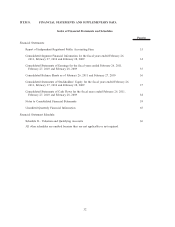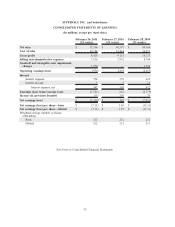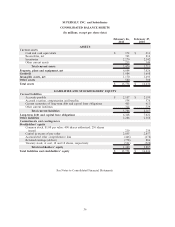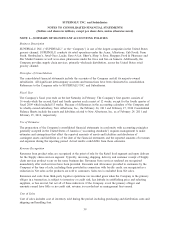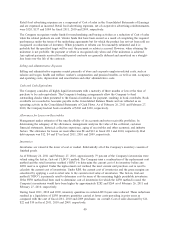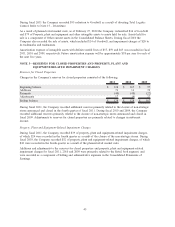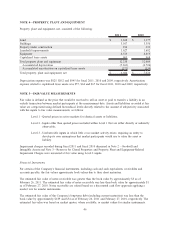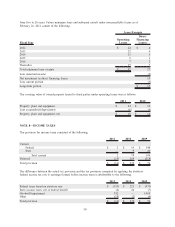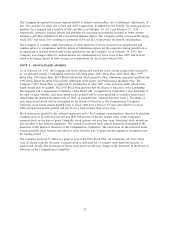Albertsons 2011 Annual Report Download - page 46
Download and view the complete annual report
Please find page 46 of the 2011 Albertsons annual report below. You can navigate through the pages in the report by either clicking on the pages listed below, or by using the keyword search tool below to find specific information within the annual report.
assets being tested. If impairment is identified for long-lived assets to be held and used, the fair value is
compared to the carrying value of the group of assets and an impairment charge is recorded for the excess of
the carrying value over the discounted future cash flows. For long-lived assets that are classified as assets held
for sale, the Company recognizes impairment charges for the excess of the carrying value plus estimated costs
of disposal over the estimated fair value. Fair value is based on current market values or discounted future
cash flows. The Company estimates fair value based on the Company’s experience and knowledge of the
market in which the property is located and, when necessary, utilizes local real estate brokers. Long-lived asset
impairment charges are a component of Selling and administrative expenses in the Consolidated Statements of
Earnings.
Deferred Rent
The Company recognizes rent holidays, including the time period during which the Company has access to the
property prior to the opening of the site, as well as construction allowances and escalating rent provisions, on
a straight-line basis over the term of the operating lease. The deferred rents are included in Other current
liabilities and Other long-term liabilities in the Consolidated Balance Sheets.
Self-Insurance Liabilities
The Company is primarily self-insured for workers’ compensation and general and automobile liability costs.
It is the Company’s policy to record its self-insurance liabilities based on management’s estimate of the
ultimate cost of reported claims and claims incurred but not yet reported and related expenses, discounted at a
risk-free interest rate. The present value of such claims was calculated using discount rates ranging from
0.6 percent to 5.1 percent for fiscal 2011 and 1.1 percent to 5.1 percent for fiscal 2010 and fiscal 2009.
Changes in the Company’s self-insurance liabilities consisted of the following:
2011 2010 2009
Beginning balance $ 1,101 $ 1,142 $ 1,132
Expense 154 190 269
Claim payments (205) (231) (259)
Ending balance 1,050 1,101 1,142
Less current portion (274) (297) (321)
Long-term portion $ 776 $ 804 $ 821
The current portion of the reserves for self-insurance is included in Other current liabilities and the long-term
portion is included in Other liabilities in the Consolidated Balance Sheets. The self-insurance liabilities as of
the end of the fiscal year are net of discounts of $178 and $191 as of February 26, 2011 and February 27,
2010, respectively.
Benefit Plans
The Company recognizes the funded status of its sponsored defined benefit plans in its Consolidated Balance
Sheets and gains or losses and prior service costs or credits not yet recognized as a component of other
comprehensive income, net of tax. The Company sponsors pension and other postretirement plans in various
forms covering substantially all employees who meet eligibility requirements. The determination of the
Company’s obligation and related expense for Company-sponsored pension and other postretirement benefits is
dependent, in part, on management’s selection of certain actuarial assumptions in calculating these amounts.
These assumptions include, among other things, the discount rate, the expected long-term rate of return on
plan assets and the rates of increase in compensation and healthcare costs.
Derivatives
The Company’s limited involvement with derivatives is primarily to manage its exposure to changes in interest
rates and energy utilized in its stores and warehouses. The Company uses derivatives only to manage well-
defined risks. The Company does not use financial instruments or derivatives for any trading or other
42


